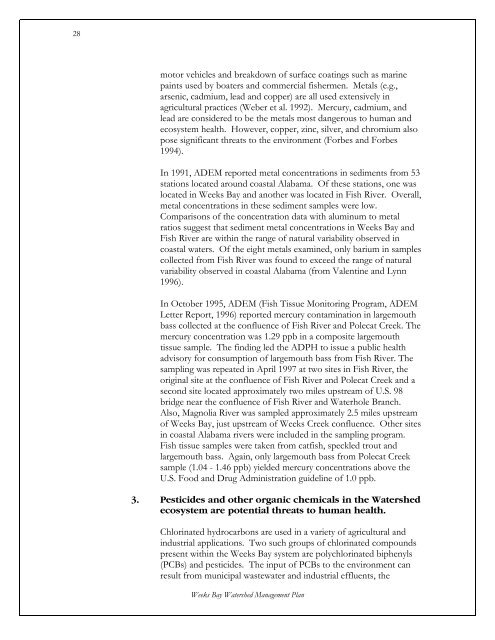Weeks Bay Watershed Project Management Plan - Mobile Bay ...
Weeks Bay Watershed Project Management Plan - Mobile Bay ...
Weeks Bay Watershed Project Management Plan - Mobile Bay ...
Create successful ePaper yourself
Turn your PDF publications into a flip-book with our unique Google optimized e-Paper software.
28<br />
motor vehicles and breakdown of surface coatings such as marine<br />
paints used by boaters and commercial fishermen. Metals (e.g.,<br />
arsenic, cadmium, lead and copper) are all used extensively in<br />
agricultural practices (Weber et al. 1992). Mercury, cadmium, and<br />
lead are considered to be the metals most dangerous to human and<br />
ecosystem health. However, copper, zinc, silver, and chromium also<br />
pose significant threats to the environment (Forbes and Forbes<br />
1994).<br />
In 1991, ADEM reported metal concentrations in sediments from 53<br />
stations located around coastal Alabama. Of these stations, one was<br />
located in <strong>Weeks</strong> <strong>Bay</strong> and another was located in Fish River. Overall,<br />
metal concentrations in these sediment samples were low.<br />
Comparisons of the concentration data with aluminum to metal<br />
ratios suggest that sediment metal concentrations in <strong>Weeks</strong> <strong>Bay</strong> and<br />
Fish River are within the range of natural variability observed in<br />
coastal waters. Of the eight metals examined, only barium in samples<br />
collected from Fish River was found to exceed the range of natural<br />
variability observed in coastal Alabama (from Valentine and Lynn<br />
1996).<br />
In October 1995, ADEM (Fish Tissue Monitoring Program, ADEM<br />
Letter Report, 1996) reported mercury contamination in largemouth<br />
bass collected at the confluence of Fish River and Polecat Creek. The<br />
mercury concentration was 1.29 ppb in a composite largemouth<br />
tissue sample. The finding led the ADPH to issue a public health<br />
advisory for consumption of largemouth bass from Fish River. The<br />
sampling was repeated in April 1997 at two sites in Fish River, the<br />
original site at the confluence of Fish River and Polecat Creek and a<br />
second site located approximately two miles upstream of U.S. 98<br />
bridge near the confluence of Fish River and Waterhole Branch.<br />
Also, Magnolia River was sampled approximately 2.5 miles upstream<br />
of <strong>Weeks</strong> <strong>Bay</strong>, just upstream of <strong>Weeks</strong> Creek confluence. Other sites<br />
in coastal Alabama rivers were included in the sampling program.<br />
Fish tissue samples were taken from catfish, speckled trout and<br />
largemouth bass. Again, only largemouth bass from Polecat Creek<br />
sample (1.04 - 1.46 ppb) yielded mercury concentrations above the<br />
U.S. Food and Drug Administration guideline of 1.0 ppb.<br />
3. Pesticides and other organic chemicals in the <strong>Watershed</strong><br />
ecosystem are potential threats to human health.<br />
Chlorinated hydrocarbons are used in a variety of agricultural and<br />
industrial applications. Two such groups of chlorinated compounds<br />
present within the <strong>Weeks</strong> <strong>Bay</strong> system are polychlorinated biphenyls<br />
(PCBs) and pesticides. The input of PCBs to the environment can<br />
result from municipal wastewater and industrial effluents, the<br />
<strong>Weeks</strong> <strong>Bay</strong> <strong>Watershed</strong> <strong>Management</strong> <strong>Plan</strong>
















